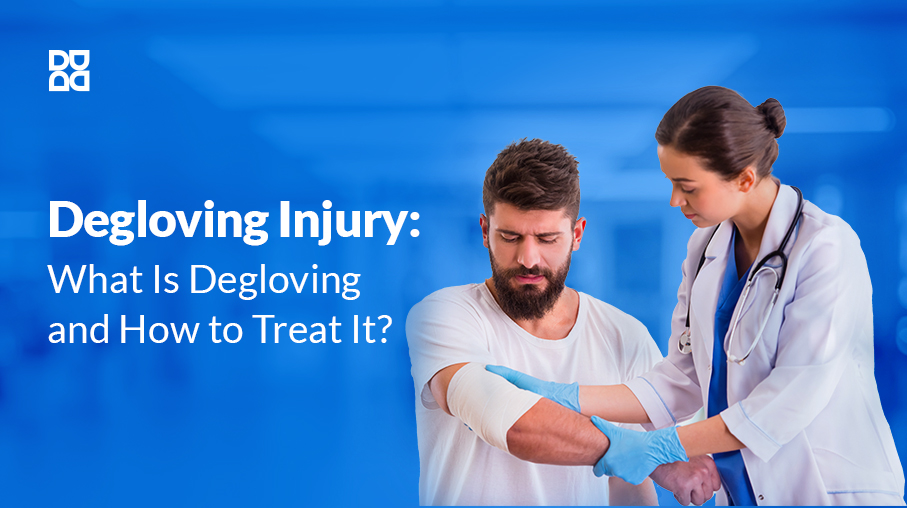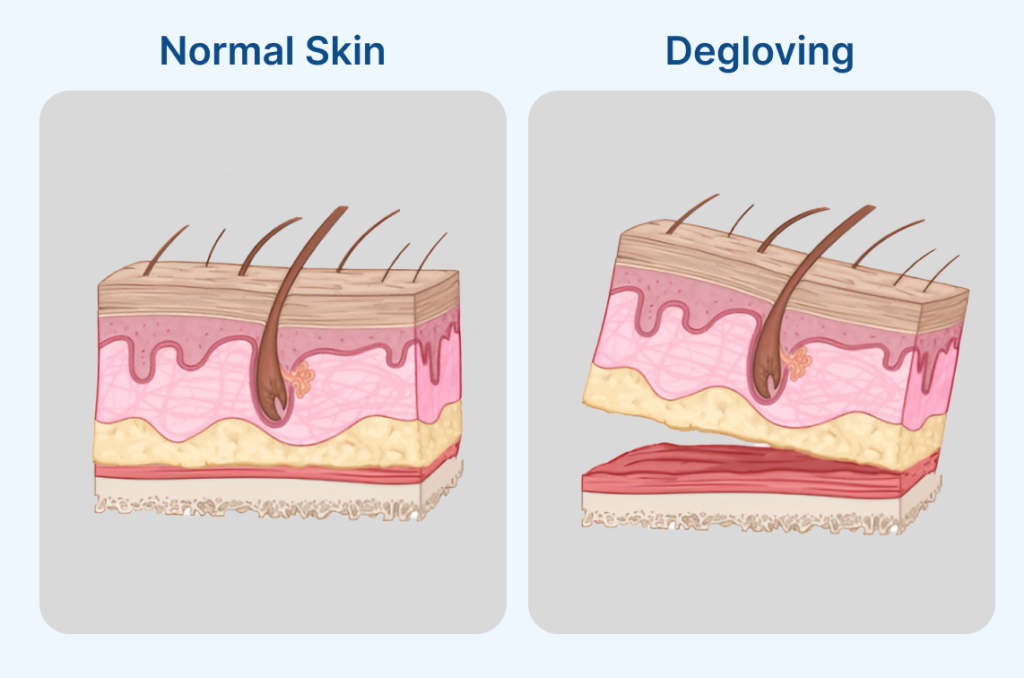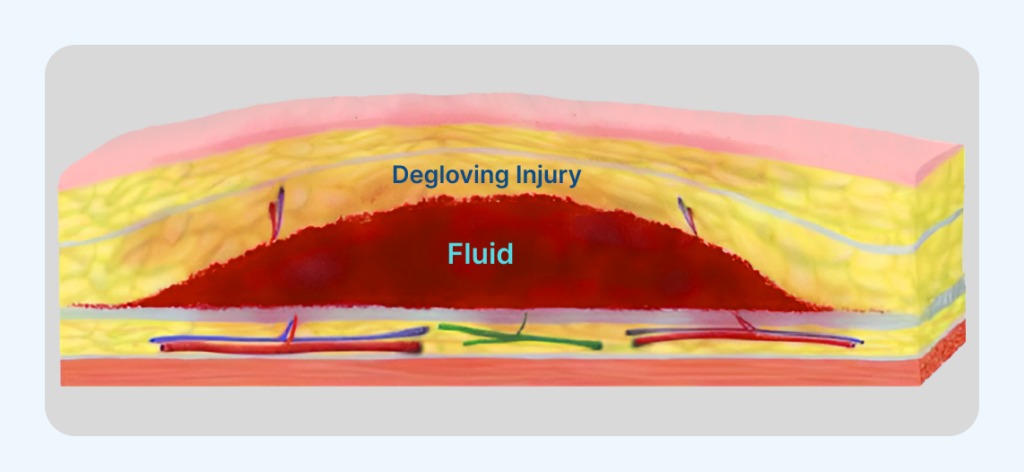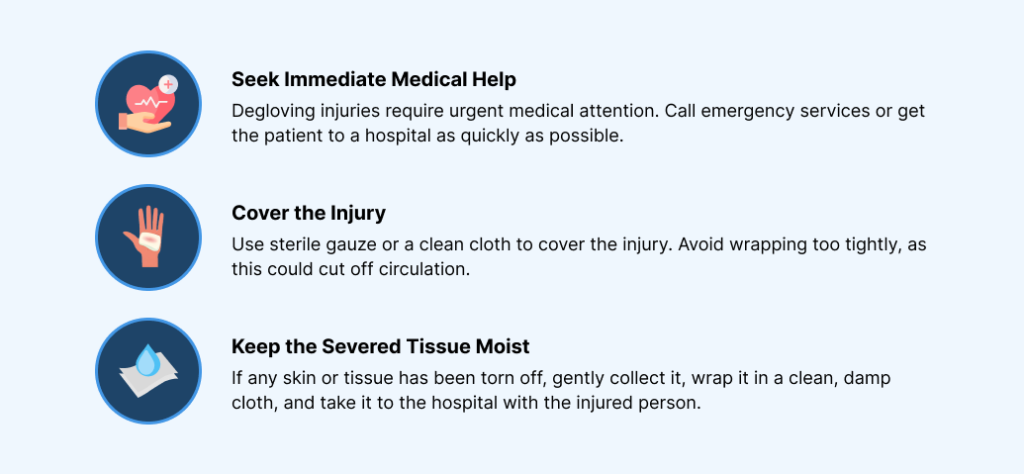
Injuries can take on many forms, but some may be more critical than others. Degloving is one such type of injury that requires immediate medical attention and specialized care to ensure proper healing and recovery.
In this blog, we will understand what degloving is, its causes, and how to care for it if it happens to you or someone you know.
What Is Degloving?
The skin consists of several layers, with the top layers serving as a protective barrier. Degloving occurs when these outer layers, along with the tissue beneath, become separated from the muscles underneath.

In simple terms, this means that the skin no longer remains securely attached as it should. Accidents or trauma often cause this condition. This injury can disrupt the blood flow to the affected area, and in more severe cases, it may expose the muscles or other tissues underneath. Degloving injuries can vary in size. They can impact a small area like a finger or cover larger regions of the body. While serious, modern medical treatments can effectively manage these injuries and aid recovery.
Types of Degloving Injuries
There are two primary types of degloving injuries:
➡️ Open Degloving
As the name suggests, open degloving results in a visible open wound, where the skin is torn off, exposing the underlying tissues and sometimes even the bone. In some cases, the skin may remain partially attached as a flap, or it may be completely separated from the area. Open degloving injuries frequently result from accidents or trauma and typically occur in areas like the hands, legs, or face. Due to the exposure of tissues, this type of injury poses a high risk of infection and requires immediate medical attention to reduce complications and promote healing.
➡️ Closed Degloving
Closed degloving is different in that the skin remains intact, but the injury occurs beneath the surface. Although there’s no visible tearing, it is an internal injury where the skin and underlying tissues separate, forming a space between the layers that may fill up with blood, liquified fat, or other fluids. As opposed to open degloving, the lack of obvious external signs makes closed degloving more difficult to detect, and it can go unnoticed without proper medical evaluation. Often, imaging like an MRI or ultrasound is necessary to diagnose and treat this condition, which can be just as serious as open degloving.

Common Areas Affected by Degloving Injuries
While degloving can affect any part of the body, certain areas are more likely to sustain these injuries due to their structure and exposure to external forces.
► Degloved Hand
Hands are especially at risk due to frequent exposure to accidents or machinery. In these injuries, the skin and underlying tissues are separated from the muscles and bones. A degloving injury to the hand can damage the skin and tissues, potentially affecting the hand's movement and function.
► Degloved Finger
A degloving injury to the finger involves the skin and tissue being partially or completely pulled away. This can also occur while forcefully removing a ring. These injuries are more common in industrial or work-related settings and need immediate treatment to prevent long-term effects.
► Degloved Face
Though rare, facial degloving can occur in high-impact situations, such as vehicle accidents. Besides the physical injury, it can also be emotionally challenging because it affects appearance.
► Degloved Legs and Feet
These areas are often affected in road accidents or due to machinery-related injuries. Degloving of the legs and feet requires careful treatment to prevent infection and ensure proper healing of the tissues.
What Causes Degloving Injuries?
Degloving injuries can occur for several reasons, all involving trauma that separates the skin from the tissues beneath. While there are many possible causes, they generally happen when the skin is subjected to intense pressure or force. Here are some common scenarios:
➡️ Motor Vehicle Accidents
High-speed accidents often involve severe trauma, particularly to the extremities or face, where the impact can cause the skin to be pulled away.
➡️ Industrial or Farm Accidents
Working with heavy machinery or tools can sometimes cause accidents where the skin gets caught, pinched, or pulled, leading to degloving injuries on the hands, arms, or legs.
➡️ Heavy Objects
If a heavy object falls on a part of your body, the pressure can cause the skin to detach from the muscle and tissue beneath it, leading to a degloving injury.
➡️ Hair Caught in Machinery
For example, if your hair gets caught in a motor, the pulling force can lead to degloving on the scalp, where the skin may be pulled away due to the tension.
➡️ Sports Injuries
Certain sports, like cycling or contact sports, can sometimes result in degloving if the skin gets caught or dragged against an object or surface.
➡️ Animal Bites
Although rare, severe animal bites can sometimes pull the skin away from the tissue, especially on the face or limbs.
These injuries often occur in environments where there is a high risk of trauma, such as workspaces with machinery, on the road, or during intense physical activities.
First Aid Measures for Degloving Injuries
Immediate first aid is crucial in minimizing further damage and increasing the chances of successful treatment. Here’s what should be done in case of a degloving injury:

How Is Degloving Treated?
The treatment of degloving injuries depends on the severity and the location of the injury. In most cases, a combination of procedures and therapies is used to manage the wound and promote recovery. Here’s a breakdown of the typical treatment process:
► Wound Cleaning (Debridement)
For open degloving injuries, wound cleaning is an essential first step. Since the skin has been removed, the area might be exposed to debris and bacteria. The wound is carefully cleaned using sterile tools to remove dirt, debris, and any damaged tissue that could prevent healing. This process helps minimize the risk of infection and supports a cleaner recovery.
► Skin Grafts
If doctors cannot reattach the original skin, they may need to perform skin grafting. In this procedure, they take skin from another part of the body and use it to cover the wound. This helps the wound heal more effectively and reduces scarring. Surgeons commonly use grafts for large areas where significant tissue loss occurs.
► Drainage
For closed degloving injuries, the primary treatment often involves draining the excess fluid and blood that accumulates under the skin. Surgeons can address this through surgical or minimally invasive methods, depending on the size and location of the injury.
► Compression Bandages
After draining the wound, healthcare providers may apply compression bandages to the injured area to promote proper healing and prevent fluid buildup. These bandages help the tissues reattach and heal more smoothly.
► Surgery
Surgical intervention is a common approach in treating degloving injuries. Surgeons may reattach the skin, repair damaged tissue, or, in more severe cases, reconstruct the area using grafts or other techniques. In extreme cases where tissue damage is extensive and doctors cannot repair it, they may require amputation.
► Physical Therapy
After the injury heals, therapists may recommend physical therapy, especially if the affected area involves joints or limbs. Rehabilitation helps restore movement, strength, and function. This is particularly important for degloving injuries to the hands or legs, where mobility could be impacted.
► Infection Prevention
Because degloving injuries expose the underlying tissues, there’s a higher risk of infection. Doctors often prescribe antibiotics to prevent infections. They emphasize the importance of regular wound monitoring.
How Much Does It Cost?
The degloving injury treatment cost can vary widely depending on factors like the severity of the injury, the type of medical care required, and the location where treatment is received. Here are some key factors that contribute to the overall cost:
➡️ Surgical Procedures
Depending on the extent of the injury, doctors may need to perform multiple surgeries, including the initial wound repair and follow-up reconstructive procedures. Each surgery can be costly, with total costs varying based on the complexity of the procedure and the region.
➡️ Hospitalization
For severe injuries, extended hospital stays may be necessary, sometimes requiring intensive care. Daily hospital fees, which can reach thousands of dollars, add to the total expense.
➡️ Rehabilitation
After surgical treatment, patients may require physical or occupational therapy to regain mobility and strength, particularly for injuries affecting the hands, legs, or other vital areas. These therapies can span weeks or months, adding to the cost of the recovery process.
➡️ Medications and Aftercare
The ongoing costs of medications like antibiotics and pain relievers, as well as regular follow-up appointments, wound care supplies, and other aftercare services, can contribute significantly to the overall expense.
In some regions, health insurance may cover part or all of the treatment, but out-of-pocket expenses can still be substantial for those without comprehensive coverage.
Managing Treatment Costs With Denefits
Injuries can happen anytime, anywhere. And with them accompany unexpected medical expenses, which can prove to be a financial burden for many. However, Denefits provides a solution to help you manage these costs with ease. With flexible payment plans, no-credit-check options, and a 95% approval rate, Denefits allows you to access the treatment you need without the financial stress. Whether it’s a degloving injury or other medical care, Denefits ensures that you can focus on healing without worrying about overbearing costs.
Learn MoreConclusion
Degloving injuries, while serious, are treatable with the right medical care. Though they may require a multi-step approach that includes surgery, rehabilitation, and follow-up care, many individuals make a strong recovery and regain function in the affected areas. It's essential to seek the necessary care as soon as possible to minimize complications. Early treatment and proper care are key to ensuring a successful recovery.




